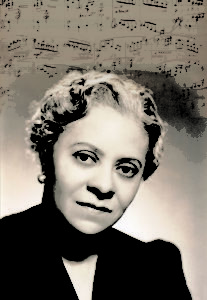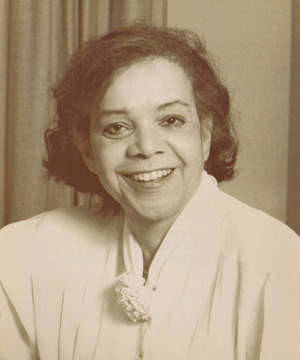Samantha Ege is not only an accomplished pianist, but an accomplished scholar as well. She’s written the following notes to provide insights into her program.
Florence Beatrice Price (1887-1953)

Florence
Price was born in Little Rock Arkansas in 1887. Her musical education
began at the age of three with piano lessons from her mother. At the
age of 19, she graduated with the highest honours earning a double
major in piano teaching and organ performance from the New England
Conservatory of Music. Five years after moving to Chicago, Price
entered the 1932 Rodman Wanamaker Music Contest, which was a national
competition for African-American composers. Price came first in the
piano composition category with her
Sonata in E Minor
and also won the symphonic category with her
Symphony in E Minor.
Price is recognised as the first African-American woman composer to
achieve national and international success.
The
Sonata
in E minor
(1932) consists of three movements: ‘Andante – Allegro,’
‘Andante’ and ‘Scherzo.’ The movements are strongly connected
and each one reflects an array of influences from classical forms and
German Romanticism, to spiritual melodies and plantation dances. The
first movement explores two spiritual themes that resurface in
various guises as the sonata progresses. The second movement delves
even deeper into the sound world of the spiritual. The third movement
embarks on a virtuosic whirl around African-American folk music and
classical conventions.
Price dedicated Fantasie Negre (1929) to Margaret Bonds. The work is virtuosic and almost improvisatory in character. Price borrows her theme from the Negro Spiritual “Sinner, Please Don’t Let This Harvest Pass.” This lends a highly evocative quality to the work that certainly captured the attention of Price’s contemporaries in the arts. A dance troupe led by Russian ballet teacher Ludmilla Speranza and pioneering African-American choreographer Katherine Dunham, premiered Fantasie Negre as a ballet. Bonds, a frequent and familiar interpreter of Price’s works, accompanied the performance.
Margaret Allison Bonds (1913-1972)

Margaret Bonds was born in Chicago and grew up during a cultural renaissance led by African American visionaries and thinkers in all spheres. The home that Margaret lived in with her mother, Estella C. Bonds, was a cultural hub for artists and intellectuals alike. Her circles included composers such as Will Marion Cook, performers such as the soprano Abbie Mitchell and poets such as Langston Hughes. Her mother, Estella, was a gifted musician and Margaret was instilled with the same passion. The younger Bonds later rose to prominence with her own works and performances, and came to represent the next wave of African-American composers in Chicago. When Florence Price moved to Chicago in 1927, she was welcomed into the Bonds family. Both mother and daughter became cherished friends of Price.
Bonds’
compositional output consists of solo piano pieces, ensemble works
and art songs. As a composer, she fills European forms with spiritual
melodies, blues harmonies and jazz rhythms. Troubled
Water
for solo piano was composed in 1967 and is often performed as a
stand-alone work, though it belongs to a set called the Spiritual
Suite. This set draws influence from specific spirituals, and in the
case of Troubled Water, Bonds constructs this work around “Wade in
the Water.” Bonds encases the melody of this spiritual in jazzy
chords and builds up to moments of gushing Romanticism. Yet, the
distinctive “Wade in the Water” melody grounds Troubled Water in
the unromantic reality of African-American history.
Regina Harris Baiocchi (b.1956)

Regina Harris Baiocchi was born in Chicago, Illinois and continues to reside there to this day. Her upbringing was especially musical: her mother, an enthusiastic singer, enrolled a young, four-year-old Baiocchi into the Chicago Girls Choir at the Metropolitan Church in Bronzeville. Her father’s expansive vast collection also contributed to Baiocchi’s musical childhood. At the age of ten, Baiocchi began to compose original works and later went on to study composition at Roosevelt University’s Chicago Musical College, which is where she earned in B.A. in Composition.
Along Baiocchi’s journey as a composer, Dr. Hale Smith became one of her most important mentors and champions. Baiocchi describes Azuretta as her “musical reaction to a debilitating stroke Dr. Hale Smith suffered in 2000. It was unbearable to witness my mentor, friend and master composer rendered mute and paralyzed. Hale was such a vibrant man who loved to talk, hold court; and he had the goods to do so. Unfortunately, Hale subsisted in a mute, paralyzed state until he passed 24 November 2009. Fortunately, Hale’s incredible legacy speaks for him and itself.” Azuretta begins wistfully with a light and lyrical melody accompanied by jazz-inspired harmonies. The increasingly dissonant middle section conveys the turmoil and tragedy of Baiocchi and Smith’s experience. When the opening melody returns, the music is not quite how it was, but its return brings a sense of closure to this incredibly emotive piece.
Dolores White (b. 1932)

Dolores White was born in Chicago, Illinois and currently reside in Cleveland, Ohio. White began piano lessons at a young age and aspired to be a concert pianist. She was inspired by African-American pianists Natalie Hinderas, Phillippa Schuyler and Frances Walker. She received her B.M in Piano Performance from Oberlin College Conservatory of Music and her M.M. in Piano Performance and Composition at the Cleveland Institute of Music. White became increasingly drawn to composition and drew significant influence from the Western classical tradition, from the contrapuntal passagework of Bach to the dissonant expressiveness of atonal styles.
On the subject of composition, White says: “I began composing music late, during my graduate years in graduate college. My concept of consonant, and dissonant sounds had changed greatly. I believe music is a science and should constantly develop, expand, explore. My Toccata (2011) was inspirational as a challenge, taking from the historical and expanding with harmonic, dissonant contrapuntal sounds, rhythms, dramatic expressiveness, lyricism and virtuoso passageworks.” White’s Toccata pays tribute to the Baroque origins of the style. The Italian word toccata translates as “touched.” It is an apt description for a genre designed to showcase the keyboardist’s touch through virtuosic passages and apt description for the virtuosic display found in White’s Toccata.
Samantha Ege’s full program:
Sonata in E minor Florence Price (1887 – 1953)
I. Andante – Allegro
II. Andante
III. Scherzo
Troubled Water Margaret Bonds (1913 – 1972)
Azuretta Regina Harris Baiocchi (b.1956)
Toccata Dolores White (b. 1932)
Fantasie Negre Florence Price (1887 – 1953)
